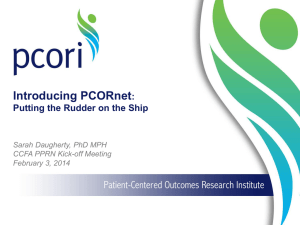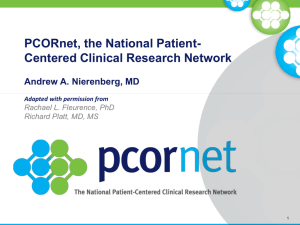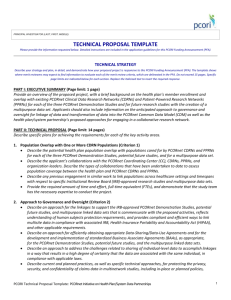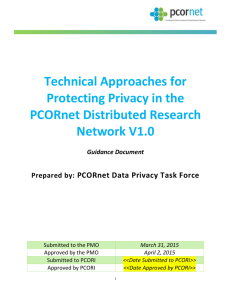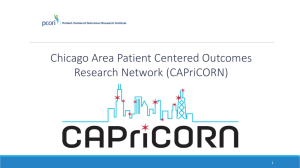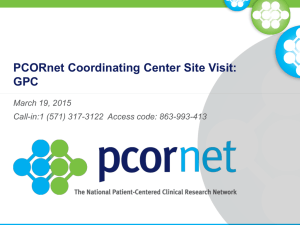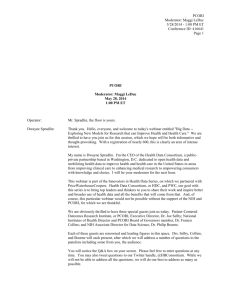PCORnet Master Slides
advertisement
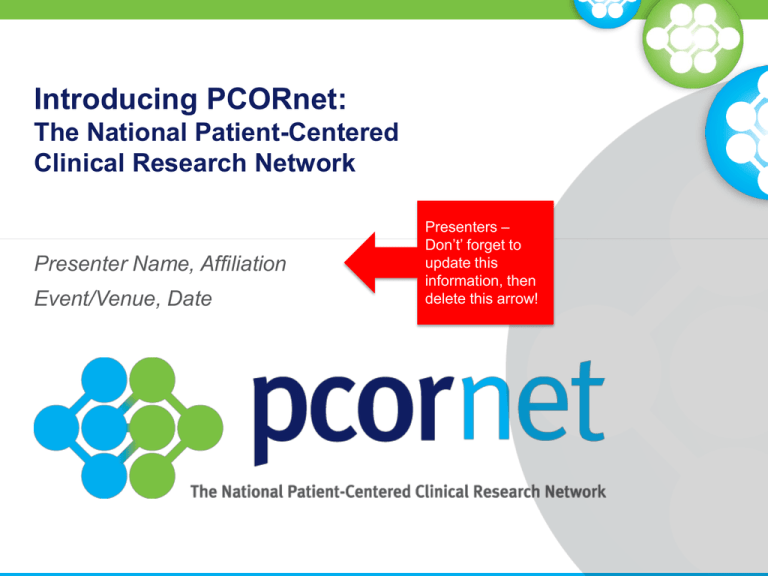
Introducing PCORnet: The National Patient-Centered Clinical Research Network Presenter Name, Affiliation Event/Venue, Date Presenters – Don’t’ forget to update this information, then delete this arrow! This slide presentation explains: Why PCORnet was created What PCORnet will do for research How it works Who is involved 3 Our national clinical research system is well-intentioned but flawed High percentage of decisions not supported by evidence* Health outcomes and disparities are not improving Current system is great except: Too slow Too expensive Unreliable Doesn’t answer questions that matter most to patients Unattractive to clinicians & administrators We are not generating the evidence we need to support the healthcare decisions that patients and their doctors have to make every day. *Tricoci P et al. JAMA 2009;301:831-41. Both researchers and funders now recognize the value in integrating clinical research networks Linking existing networks means clinical research can be conducted more effectively Ensures that patients, providers, and scientists form true “communities of research” Creates “interoperability” – networks can share sites and data PCORnet embodies a “community of research” by uniting systems, patients & clinicians 11 Clinical Data Research Networks (CDRNs) 18 PatientPowered Research Networks (PPRNs) 6 PCORnet: A national infrastructure for patient-centered clinical research What will PCORnet do for research? 7 PCORnet’s goal PCORnet seeks to improve the nation’s capacity to conduct clinical research by creating a large, highly representative, national patient-centered network that supports more efficient clinical trials and observational studies. 8 PCORnet’s vision PCORnet will support widespread capability for the US healthcare system to learn from research, meaning that large-scale research can be conducted with greater speed and accuracy within real-world care delivery systems. 9 Overall objectives of PCORnet: achieving a single functional research network Create a secure national research resource that will enable teams of health researchers, patients, and their partners to work together on researching questions of shared interest Utilize multiple rich data sources to support research, such as electronic health records, insurance claims data, and data reported directly by patients Engage patients, clinicians & health system leaders throughout the research cycle from idea generation to implementation Support observational and interventional research studies that compare how well different treatment options work for different people Enable external partners to collaborate with PCORI-funded networks Sustain PCORnet resources for a range of research activities supported by PCORI and other sponsors 10 PCORnet organizational structure 11 29 CDRN and PPRN awards were approved on December 17th by PCORI’s Board of Governors This map depicts the number of PCORI-funded Patient-Powered or Clinical Data Research Networks that have coverage in each state. 12 CDRN Partners 13 Goals for Each Clinical Data Research Network (CDRN) Create a research-ready dataset of at least 1 million patients that is: Secure and does not identify individual patients Comprehensive, using data from EHRs to describe patients’ care experience over time and in different care settings Involve patients, clinicians, and health system leaders in all aspects of creating and running the network Develop the ability to run a clinical trial in the participating systems that fits seamlessly into healthcare operations Identify at least 3 cohorts of patients who have a condition in common, and who can be characterized and surveyed 14 CDRN highlights • Networks of academic health centers, hospitals & clinical practices • Networks of non-profit integrated health systems • Networks of Federally Qualified Health Centers (FQHCs) serving low-income communities • • • • • Networks leveraging NIH and AHRQ investments (CTSAs) Clinical & Translational Science Awardees Inclusion of Health Information Exchanges Wide geographical spread Health Information Exchanges Inclusion of under-served populations Range from 1M covered lives to 28M Academic Health Centers Integrated Delivery Systems Safety Net Clinics 15 PPRN Partners 16 Goals for each Patient-Powered Research Network (PPRN) Establish an activated patient population with a condition of interest (Size >50 patients for rare diseases; >50,000 for common conditions) Collect patient-reported data for ≥80% of patients in the network Involve patients in network governance Create standardized database suitable for sharing with other network members that can be used to respond to “queries” (ideas for possible research studies) 17 PPRN highlights Participating organizations and leadership teams include patients, advocacy groups, clinicians, academic centers, practice-based research networks Strong understanding of patient engagement Significant range of conditions and diseases Variety in populations represented (including pediatrics; under-served populations) 50% are focused on rare diseases Varying capabilities with respect to developing research data Several PPRNs have capacity to work with biospecimens 18 The PCORnet opportunity: making a real difference for patients and their families Until now, we have been unable to answer many of the most important questions affecting health and healthcare. By combining the knowledge and insights of patients, caregivers, and researchers in a revolutionary network with carefully controlled access to rich sources of health data, we will be able to respond to patients’ priorities and speed the creation of new knowledge to guide treatment on a national scale. 19
